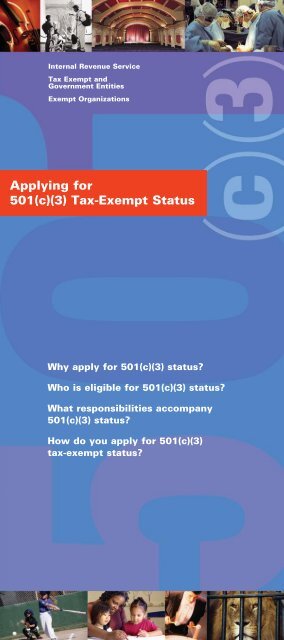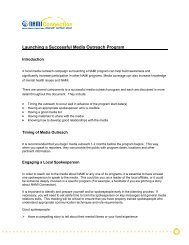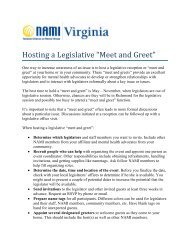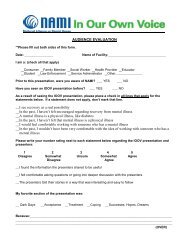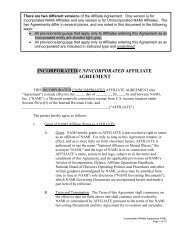Applying for 501(c)(3) Tax-Exempt Status
Applying for 501(c)(3) Tax-Exempt Status - NAMI-NC
Applying for 501(c)(3) Tax-Exempt Status - NAMI-NC
- No tags were found...
You also want an ePaper? Increase the reach of your titles
YUMPU automatically turns print PDFs into web optimized ePapers that Google loves.
Internal Revenue Service<br />
<strong>Tax</strong> <strong>Exempt</strong> and<br />
Government Entities<br />
<strong>Exempt</strong> Organizations<br />
<strong>Applying</strong> <strong>for</strong><br />
<strong>501</strong>(c)(3) <strong>Tax</strong>-<strong>Exempt</strong> <strong>Status</strong><br />
Why apply <strong>for</strong> <strong>501</strong>(c)(3) status?<br />
Who is eligible <strong>for</strong> <strong>501</strong>(c)(3) status?<br />
What responsibilities accompany <br />
<strong>501</strong>(c)(3) status?<br />
How do you apply <strong>for</strong> <strong>501</strong>(c)(3) <br />
tax-exempt status?
01<br />
2<br />
Why apply <strong>for</strong> <strong>501</strong>(c)(3) status? . . . . . . . . . . . . . . . . . .<br />
Who is eligible <strong>for</strong> <strong>501</strong>(c)(3) status? . . . . . . . . . . . . . 2<br />
<strong>501</strong>(c)(3) Organizations . . . . . . . . . . . . . . . . . . . . . . . . . . 4<br />
Public Charities and Private Foundations . . . . 5<br />
What responsibilities<br />
accompany <strong>501</strong>(c)(3) status? . . . . . . . . . . . . . . . . . . . . . 7<br />
Recordkeeping . . . . . . . . . . . . . . . . . . . . . . . . . . . . . . . . . . . . 7<br />
Filing Requirements . . . . . . . . . . . . . . . . . . . . . . . . . . . . . 7<br />
Disclosure Requirements . . . . . . . . . . . . . . . . . . . . . . . 8<br />
Recordkeeping Requirements . . . . . . . . . . . . . . . . . . 9<br />
How do you apply <strong>for</strong> <strong>501</strong>(c)(3) status?. . . . . . . 10<br />
Forms to File . . . . . . . . . . . . . . . . . . . . . . . . . . . . . . . . . . . . 10<br />
When to File. . . . . . . . . . . . . . . . . . . . . . . . . . . . . . . . . . . . . 11<br />
Determination Letter. . . . . . . . . . . . . . . . . . . . . . . . . . . 11<br />
While Your Application is Pending . . . . . . . . . . 12<br />
How to get IRS assistance and in<strong>for</strong>mation . . 12<br />
Specialized Assistance<br />
<strong>for</strong> <strong>Tax</strong>-<strong>Exempt</strong> Organizations . . . . . . . . . . . . . . . 13<br />
Publications . . . . . . . . . . . . . . . . . . . . . . . . . . . . . . . . . . . . . 14<br />
Forms . . . . . . . . . . . . . . . . . . . . . . . . . . . . . . . . . . . . . . . . . . . . 14
(c)(3)<br />
Federal tax law provides tax benefits to nonprofit<br />
organizations recognized as exempt from federal income<br />
tax under section <strong>501</strong>(c)(3) of the Internal Revenue Code<br />
(IRC). It requires that most organizations apply to the<br />
Internal Revenue Service (IRS) <strong>for</strong> that status.<br />
This IRS Publication 4220 presents general guidelines <strong>for</strong><br />
organizations that seek tax-exempt status from federal<br />
income tax under section <strong>501</strong>(c)(3) of the IRC. Content<br />
includes references to the statute, Treasury regulations,<br />
other IRS publications that explain the requirements<br />
<strong>for</strong> tax-exempt status, and IRS <strong>for</strong>ms with instructions.<br />
Publication 4220 is neither comprehensive nor intended<br />
to address every situation. As an alternative to applying<br />
<strong>for</strong> exemption, an organization may obtain many of the<br />
benefits of <strong>501</strong>(c)(3) status by affiliating with an existing<br />
charity that acts as its agent. It is important to note<br />
that the existing charity must be given full control and<br />
authority over the program.<br />
To learn more about the rules and procedures that<br />
pertain to organizations applying <strong>for</strong> exemption from<br />
federal income tax under section <strong>501</strong>(c)(3) of the<br />
IRC, see Publication 557, <strong>Tax</strong>-<strong>Exempt</strong> <strong>Status</strong> <strong>for</strong> Your<br />
Organization. For assistance on <strong>501</strong>(c)(3) status, you<br />
may also want to consult a tax adviser.
Why apply<br />
<strong>for</strong> <strong>501</strong>(c)(3) status?<br />
The benefits of having <strong>501</strong>(c)(3) status include<br />
exemption from federal income tax and eligibility<br />
to receive tax-deductible charitable contributions. To<br />
qualify <strong>for</strong> these benefits, most organizations must<br />
file an application with, and be recognized by, the<br />
IRS as described in this publication. Another benefit<br />
is that some organizations may be exempt from<br />
certain employment taxes.<br />
Individual and corporate donors are more likely to<br />
support organizations with <strong>501</strong>(c)(3) status because<br />
their donations can be tax deductible. Recognition of<br />
exemption under section <strong>501</strong>(c)(3) of the IRC assures<br />
foundations and other grant-making institutions that<br />
they are issuing grants or sponsorships to permitted<br />
beneficiaries.<br />
An IRS determination of <strong>501</strong>(c)(3) status is recognized<br />
and accepted <strong>for</strong> other purposes. For example: state<br />
officials may grant exemption from state income,<br />
sales, and property taxes; and the U.S. Postal Service<br />
offers reduced postal rates to certain organizations.<br />
Who is eligible<br />
<strong>for</strong> <strong>501</strong>(c)(3) status?<br />
There are three key components <strong>for</strong> an organization<br />
to be exempt from federal income tax under section<br />
<strong>501</strong>(c)(3) of the IRC. A not-<strong>for</strong>-profit (i.e., nonprofit)<br />
organization must be organized and operated exclusively<br />
<strong>for</strong> one or more exempt purposes.<br />
organized—A <strong>501</strong>(c)(3) organization must be<br />
organized as a corporation, trust, or unincorporated<br />
association. An organization’s organizing documents
(articles of incorporation, trust documents, articles<br />
of association) must: limit its purposes to those<br />
described in section <strong>501</strong>(c)(3) of the IRC; not<br />
expressly permit activities that do not further its<br />
exempt purpose(s), i.e., unrelated activities; and permanently<br />
dedicate its assets to exempt purposes.<br />
operated—Because a substantial portion of an<br />
organization’s activities must further its exempt<br />
purpose(s), certain other activities are prohibited or<br />
restricted including, but not limited to, the following<br />
activities. A <strong>501</strong>(c)(3) organization:<br />
n must absolutely refrain from participating in the<br />
political campaigns of candidates <strong>for</strong> local, state,<br />
or federal office<br />
n must restrict its lobbying activities to an insubstantial<br />
part of its total activities<br />
n must ensure that its earnings do not inure to the<br />
benefit of any private shareholder or individual<br />
n must not operate <strong>for</strong> the benefit of private interests<br />
such as those of its founder, the founder’s family,<br />
its shareholders or persons controlled by such<br />
interests<br />
n must not operate <strong>for</strong> the primary purpose of<br />
conducting a trade or business that is not related<br />
to its exempt purpose, such as a school’s operation<br />
of a factory<br />
n may not have purposes or activities that are<br />
illegal or violate fundamental public policy<br />
exempt purpose—To be tax exempt, an organization<br />
must have one or more exempt purposes,<br />
stated in its organizing document. Section <strong>501</strong>(c)(3)<br />
of the IRC lists the following exempt purposes:<br />
charitable, educational, religious, scientific, literary,<br />
fostering national or international sports competition,<br />
preventing cruelty to children or animals, and<br />
testing <strong>for</strong> public safety.
<strong>501</strong>(c)(3) Organizations<br />
The most common types of <strong>501</strong>(c)(3) organizations<br />
are charitable, educational, and religious.<br />
CHARITAblE<br />
Charitable organizations conduct activities that promote:<br />
- relief of the poor, the distressed, or the underprivileged<br />
- advancement of religion<br />
- advancement of education or science<br />
- erection or maintenance of public buildings,<br />
monuments, or works<br />
- lessening the burdens of government<br />
- lessening neighborhood tensions<br />
- eliminating prejudice and discrimination<br />
- defending human and civil rights secured by law<br />
- combating community deterioration and juvenile<br />
delinquency<br />
EduCATIOnAl<br />
Educational organizations include:<br />
- schools such as a primary or secondary school, a<br />
college, or a professional or trade school<br />
- organizations that conduct public discussion groups,<br />
<strong>for</strong>ums, panels, lectures, or similar programs<br />
- organizations that present a course of instruction<br />
by means of correspondence or through the use of<br />
television or radio<br />
- museums, zoos, planetariums, symphony orchestras,<br />
or similar organizations<br />
- nonprofit day-care centers<br />
- youth sports organizations<br />
RElIGIOuS<br />
The term church includes synagogues, temples,<br />
mosques, and similar types of organizations. Although<br />
the IRC excludes these organizations from the requirement<br />
to file an application <strong>for</strong> exemption, many churches<br />
voluntarily file applications <strong>for</strong> exemption. Such<br />
recognition by the IRS assures church leaders, members,<br />
and contributors that the church is tax exempt under<br />
section <strong>501</strong>(c)(3) of the IRC and qualifies <strong>for</strong> related tax<br />
benefits. Other religious organizations that do not carry<br />
out the functions of a church, such as mission organizations,<br />
speakers’ organizations, nondenominational<br />
ministries, ecumenical organizations, or faith-based<br />
social agencies, may qualify <strong>for</strong> exemption. These organizations<br />
must apply <strong>for</strong> exemption from the IRS. See<br />
Publication 1828, <strong>Tax</strong> Guide <strong>for</strong> Churches and Religious<br />
Organizations, <strong>for</strong> more details.
Public Charities and Private Foundations<br />
Every organization that qualifies <strong>for</strong> tax-exempt<br />
status under section <strong>501</strong>(c)(3) of the IRC is further<br />
classified as either a public charity or a private<br />
foundation. Under section 508 of the IRC, every<br />
organization is automatically classified as a private<br />
foundation unless it meets one of the exceptions<br />
listed in section 509(a).<br />
For some organizations, the primary distinction<br />
between a classification as a public charity or a<br />
private foundation is the organization’s source of<br />
financial support. Generally, a public charity has a<br />
broad base of support while a private foundation<br />
has very limited sources of support. This classification<br />
is important because different tax rules apply<br />
to the operations of each. Deductibility of contributions<br />
to a private foundation is more limited than<br />
deductibility of contributions to a public charity.<br />
See Publication 526, Charitable Contributions, <strong>for</strong><br />
more in<strong>for</strong>mation on deductibility of contributions.<br />
In addition, private foundations are subject<br />
to excise taxes that are not imposed on public<br />
charities. For more in<strong>for</strong>mation about the special<br />
tax rules that apply to private foundations,<br />
see Publication 4221-PF, Compliance Guide <strong>for</strong><br />
50(c)() Private Foundations; and the Life Cycle of<br />
a Private Foundation website on www.irs.gov/eo.<br />
Organizations statutorily classified as public<br />
charities under section 509(a) of the IRC are:<br />
n churches<br />
n schools<br />
n organizations that provide medical or hospital<br />
care (including the provision of medical education<br />
and in certain cases, medical research)<br />
5
n organizations that receive a substantial part of<br />
their support in the <strong>for</strong>m of contributions from<br />
publicly supported organizations, governmental<br />
units, and/or from the general public<br />
n organizations that normally receive not more<br />
than one-third of their support from gross investment<br />
income and more than one-third of their<br />
support from contributions, membership fees,<br />
and gross receipts from activities related to their<br />
exempt functions<br />
n organizations that support other public charities<br />
If the organization requests public charity<br />
classification based on receiving support from the<br />
public, it must continue to seek significant and<br />
diversified public support in later years. A new<br />
organization that cannot show that it has received<br />
enough public support may request an advance<br />
ruling of its status. At the end of its advance ruling<br />
period, usually five years, it must file Form<br />
8734, Support Schedule <strong>for</strong> Advance Ruling Period,<br />
showing its sources of support. If the Form 8734<br />
indicates sufficient public support, the organization<br />
receives a definitive ruling of its public charity<br />
status. If the organization does not meet the<br />
public support requirements in the future, it could<br />
be reclassified as a private foundation. Unless the<br />
organization is committed to raising funds from<br />
the public, it may be more appropriate to consider<br />
alternate statutorily-based public charity classifications.<br />
See Publication 557, <strong>Tax</strong>-<strong>Exempt</strong> <strong>Status</strong> <strong>for</strong><br />
Your Organization, <strong>for</strong> assistance with determining<br />
how your organization would be classified.
What responsibilities<br />
accompany <strong>501</strong>(c)(3) status?<br />
While conferring benefits on <strong>501</strong>(c)(3) organizations,<br />
federal tax law also imposes responsibilities<br />
on organizations receiving that status.<br />
Recordkeeping<br />
Section <strong>501</strong>(c)(3) organizations are required to<br />
keep books and records detailing all activities,<br />
both financial and nonfinancial. Financial in<strong>for</strong>mation,<br />
particularly in<strong>for</strong>mation on its sources of<br />
support (contributions, grants, sponsorships, and<br />
other sources of revenue) is crucial to determining<br />
an organization’s private foundation status. See<br />
Publication 4221-PC and 4221-PF, Publication 557,<br />
and the instructions to Forms 990, 990-EZ, and 990<br />
PF <strong>for</strong> more in<strong>for</strong>mation.<br />
Filing Requirements<br />
Annual In<strong>for</strong>mation Returns – Organizations<br />
recognized as tax exempt under section <strong>501</strong>(c)(3)<br />
of the IRC may be required to file an annual<br />
in<strong>for</strong>mation return: Form 990, Form 990-EZ, or<br />
Form 990-PF along with Schedules A and B.<br />
Certain categories of organizations are excepted<br />
from filing Form 990 or Form 990-EZ including<br />
churches and very small organizations. See the<br />
instructions with each of these <strong>for</strong>ms <strong>for</strong> more<br />
in<strong>for</strong>mation.<br />
Annual Electronic Notice – Small organizations<br />
are not required to file Form 990 if their gross<br />
receipts are normally $25,000 or less. Beginning<br />
in 2008, however, these organizations must submit<br />
an annual electronic notice using Form 990<br />
N, Electronic Notice (e-Postcard) <strong>for</strong> <strong>Tax</strong>-<strong>Exempt</strong>
Organizations not Required To File Form 990 or<br />
990-EZ, also known as the e-Postcard. The e-<br />
Postcard can only be filed electronically; there is<br />
no paper version. For more in<strong>for</strong>mation about the<br />
e-Postcard, go to www.irs.gov.<br />
Unrelated Business Income <strong>Tax</strong> – In addition to<br />
filing Form 990, 990-EZ, or 990-PF, an exempt organization<br />
must file Form 990-T if it has $1,000<br />
or more of gross receipts from an unrelated trade<br />
or business during the year. The organization must<br />
make quarterly payments of estimated tax on<br />
unrelated business income if it expects its tax <strong>for</strong><br />
the year to be $500 or more. The organization may<br />
use Form 990-W to help calculate the amount of<br />
estimated payments required. In general, the tax<br />
is imposed on income from a regularly carried-on<br />
trade or business that does not further the organization’s<br />
exempt purposes (other than by providing<br />
funds). See Publication 598, <strong>Tax</strong> on Unrelated<br />
Business Income of <strong>Exempt</strong> Organizations, and the<br />
Form 990-T instructions <strong>for</strong> more in<strong>for</strong>mation.<br />
disclosure Requirements<br />
Public Inspection of <strong>Exempt</strong>ion Applications and<br />
Returns – Section <strong>501</strong>(c)(3) organizations must<br />
make their application (Form 1023) and the three<br />
most recent annual returns (Form 990 or Form<br />
990-EZ) available to the public, upon request and<br />
without charge (except <strong>for</strong> a reasonable charge <strong>for</strong><br />
copying). The IRS also makes these documents<br />
available <strong>for</strong> public inspection and copying. Private<br />
foundation returns (Form 990-PF) filed on or after<br />
March 13, 2000, are subject to the same disclosure<br />
rules. These documents must be made available<br />
at the organization’s principal office during regular<br />
business hours. Upon request, an organization
must furnish copies of the application and the three<br />
most recent annual returns. The requests may be<br />
made in person or in writing. See Publication 557 <strong>for</strong><br />
more in<strong>for</strong>mation.<br />
For tax years beginning after August 17, 2006, section<br />
<strong>501</strong>(c)(3) organizations that file unrelated business<br />
income tax returns (Forms 990-T) must make<br />
them available <strong>for</strong> public inspection.<br />
Charitable Contributions— Substantiation and<br />
Disclosure – Organizations that are tax exempt<br />
under section <strong>501</strong>(c)(3) of the IRC must meet certain<br />
requirements <strong>for</strong> documenting charitable contributions.<br />
The federal tax law imposes two general<br />
disclosure rules: 1) a donor must obtain a written<br />
acknowledgment from a charity <strong>for</strong> any single contribution<br />
of $250 or more be<strong>for</strong>e the donor can<br />
claim a charitable contribution on his/her federal<br />
income tax return; 2) a charitable organization<br />
must provide a written disclosure to a donor who<br />
makes a payment in excess of $75 partly as a<br />
contribution and partly <strong>for</strong> goods and services provided<br />
by the organization. See Publication 1771,<br />
Charitable Contributions – Substantiation and<br />
Disclosure Requirements, <strong>for</strong> more in<strong>for</strong>mation.<br />
Recordkeeping Requirements<br />
A donor cannot claim a tax deduction <strong>for</strong> any contribution<br />
of cash, a check or other monetary gift<br />
made on or after January 1, 2007, unless the donor<br />
maintains a record of the contribution in the <strong>for</strong>m of<br />
either a bank record (such as a cancelled check) or a<br />
written communication from the charity (such as a<br />
receipt or a letter) showing the name of the charity,<br />
the date of the contribution, and the amount of the<br />
contribution.<br />
9
How do you apply <br />
<strong>for</strong> <strong>501</strong>(c)(3) status?<br />
Organizations that want to apply <strong>for</strong> <strong>501</strong>(c)(3)<br />
status should be aware of the <strong>for</strong>ms required, the<br />
user fee, the filing deadline, and the processing<br />
procedures.<br />
Forms to File<br />
FORm SS-4<br />
An employer identification number (EIN) is your<br />
account number with the IRS and is required regardless<br />
of whether the organization has employees. Include the<br />
organization’s EIN on all correspondence to the IRS.<br />
Apply <strong>for</strong> an EIN by completing Form SS-4, Application<br />
<strong>for</strong> Employer Identification Number, by calling toll-free<br />
(866) 816-2065, or by submitting an online version of the<br />
<strong>for</strong>m via www.irs.gov. Form SS-4 is available at Social<br />
Security Administration offices, by request through the<br />
IRS at (800) 829-3676, and by downloading the <strong>for</strong>m from<br />
the IRS Web site at www.irs.gov. For more in<strong>for</strong>mation<br />
about EINs, see Publication 1635, Understanding Your<br />
EIN.<br />
FORm 1023<br />
Complete Form 1023, Application <strong>for</strong> Recognition of<br />
<strong>Exempt</strong>ion Under Section <strong>501</strong>(c)(3) of the Internal<br />
Revenue Code, and mail to the address indicated in the<br />
instructions. The required user fee must accompany<br />
Form 1023. The IRS will not process an application until<br />
the user fee is paid.<br />
FORmS 2848 and 8821<br />
Attach Form 2848, Power of Attorney and Declaration<br />
of Representative, if someone other than your principal<br />
officer or director will represent you on matters about<br />
the application. Attach Form 8821, <strong>Tax</strong> In<strong>for</strong>mation<br />
Authorization, if you want the IRS to be able to provide<br />
in<strong>for</strong>mation about your application to an employee<br />
other than a principal officer or director.<br />
0
When to File<br />
Most organizations must file Form 1023 by the end<br />
of the 15th month after they were created, with a<br />
12-month extension available. An organization that<br />
is not a private foundation is not required to file<br />
Form 1023 unless its annual gross receipts are normally<br />
more than $5,000. An organization must file<br />
Form 1023 within 90 days of the end of the year in<br />
which it exceeds this threshold.<br />
Example 1: An organization that was created on<br />
January 1, 2006, and exceeds the gross receipts<br />
threshold, must file Form 1023 by April 30, 2008.<br />
Example 2: An organization that was created on<br />
January 1, 2003, but did not exceed the gross<br />
receipts threshold until September 30, 2007, must<br />
file Form 1023 by March 31, 2008.<br />
An organization that files its application be<strong>for</strong>e<br />
the deadline will be recognized as tax exempt<br />
under section <strong>501</strong>(c)(3) of the IRC from the date of<br />
its creation. An organization that files an application<br />
after the deadline may be recognized as tax<br />
exempt from the date of the application; it may<br />
also request exemption retroactive as of the date<br />
of creation. See the instructions to Form 1023 <strong>for</strong><br />
more in<strong>for</strong>mation.<br />
determination letter<br />
The IRS tax specialist reviewing an application<br />
may request additional in<strong>for</strong>mation in writing. If<br />
all in<strong>for</strong>mation received establishes that an organization<br />
meets the requirements <strong>for</strong> exemption, the<br />
IRS will issue a determination letter recognizing<br />
the organization’s exempt status and providing its<br />
public charity classification. This is an important<br />
document that should be kept in the organization’s<br />
permanent records.
While Your Application Is Pending<br />
While an organization’s Form 1023 is waiting<br />
<strong>for</strong> approval from the IRS, the organization may<br />
operate as a tax-exempt organization.<br />
If an annual exempt organization return is due,<br />
the organization must file it, indicating that its<br />
application is pending. These returns are subject<br />
to public disclosure. If the organization has unrelated<br />
business income of more than $1,000, it<br />
must also file a Form 990-T. See Publication<br />
4221-PC or 4221-PF <strong>for</strong> more in<strong>for</strong>mation.<br />
Although donors have no assurance that contributions<br />
are tax-deductible <strong>for</strong> federal income tax purposes<br />
until the application is approved, contributions<br />
made while an application is pending would<br />
qualify if the application is approved. However, if<br />
the application is disallowed, contributions would<br />
not qualify. Moreover, the organization would be<br />
liable <strong>for</strong> filing federal income tax returns unless<br />
its income is otherwise excluded from federal taxation.<br />
The EO website (www.irs.gov/eo) provides in<strong>for</strong>mation<br />
about how to find out about the status of<br />
an application <strong>for</strong> tax-exempt status.<br />
How to get IRS assistance<br />
and in<strong>for</strong>mation<br />
The IRS offers help through assistors and with<br />
reading material that is accessible either online,<br />
via mail, by telephone, and at IRS walk-in offices<br />
in many areas across the country. IRS <strong>for</strong>ms and<br />
publications can be downloaded from the Internet<br />
and ordered by telephone.
Specialized Assistance<br />
<strong>for</strong> <strong>Tax</strong>-<strong>Exempt</strong> Organizations<br />
Get help with questions about applying <strong>for</strong> taxexempt<br />
status, annual filing requirements, and<br />
in<strong>for</strong>mation about exempt organizations through<br />
the IRS <strong>Exempt</strong> Organizations (EO).<br />
EO Web site<br />
www.irs.gov/eo<br />
Highlights:<br />
• The Life Cycle of a Public Charity and Life Cycle<br />
of a Private Foundation – describe the compliance<br />
obligations of charities.<br />
• Subscribe to the EO Update, an electronic newsletter<br />
with in<strong>for</strong>mation <strong>for</strong> tax-exempt organizations<br />
and tax practitioners who represent them.<br />
Web based<br />
training modules<br />
www.stayexempt.org<br />
• <strong>Tax</strong> <strong>Exempt</strong> <strong>Status</strong><br />
• Unrelated Business income<br />
• Employment Issues<br />
• Form 990<br />
• Required Disclosures<br />
EO customer service (877) 829-5500<br />
EO Determinations Office mailing address<br />
InternalRevenue Service<br />
TE/GE, EO Determinations Office<br />
P.O. Box 2508<br />
Cincinnati, OH 45201
<strong>Tax</strong> Publications <strong>for</strong><br />
<strong>Exempt</strong> Organizations<br />
GET PUBlICATIONS vIA THE INTERNET<br />
OR BY CAllING THE IRS AT (800) 829-3676:<br />
Pub 15, Circular E, Employer’s <strong>Tax</strong> Guide<br />
Pub 15-A, Employer’s Supplemental <strong>Tax</strong> Guide<br />
Pub 463, Travel, Entertainment, Gift, and Car Expenses<br />
Pub 517, Social Security and Other In<strong>for</strong>mation <strong>for</strong><br />
Members of the Clergy and Religious Workers<br />
Pub 526, Charitable Contributions<br />
Pub 538, Accounting Periods and Methods<br />
Pub 557, <strong>Tax</strong>-<strong>Exempt</strong> <strong>Status</strong> <strong>for</strong> Your Organization<br />
Pub 583, Starting a Business and Keeping Records<br />
Pub 598, <strong>Tax</strong> on Unrelated Business Income of <strong>Exempt</strong><br />
Organizations<br />
Pub 1771, Charitable Contributions – Substantiation and<br />
Disclosure Requirements<br />
Pub 1828, <strong>Tax</strong> Guide <strong>for</strong> Churches and Religious<br />
Organizations<br />
Pub 3079, Gaming Publication <strong>for</strong> <strong>Tax</strong>-<strong>Exempt</strong> <br />
Organizations<br />
Pub 3833, Disaster Relief, Providing Assistance<br />
Through Charitable Organizations<br />
Pub.4202, A Charity’s Guide to Vehicle Donations<br />
Pub.4203, A Donor’s Guide to Vehicle Donations<br />
Pub 4220, <strong>Applying</strong> <strong>for</strong> <strong>501</strong>(c)(3) <strong>Tax</strong>-<strong>Exempt</strong> <strong>Status</strong><br />
Publication 4221-PC, Compliance Guide <strong>for</strong> <strong>501</strong>(c)(3) Public<br />
Charities<br />
Pub 4221-PF, Compliance Guide <strong>for</strong> <strong>501</strong>(c)(3) Private<br />
Foundations<br />
Forms <strong>for</strong> <strong>Exempt</strong> Organizations<br />
GET FORmS vIA THE INTERNET OR BY <br />
CAllING THE IRS AT (800) 829-3676: <br />
Form SS-4, Application <strong>for</strong> Employer Identification<br />
Number<br />
Form 941, Employer’s Quarterly Federal <strong>Tax</strong> Return<br />
Form 990, Return of Organization <strong>Exempt</strong> From Income<br />
<strong>Tax</strong>
Form 990-EZ, Short Form Return of Organization <strong>Exempt</strong><br />
From Income <strong>Tax</strong><br />
Form 990-PF, Return of Private Foundation or Section<br />
4947(a)(1) Nonexempt Charitable Trust Treated as a Private<br />
Foundation<br />
Schedule A, of Form 990 or 990-EZ, Supplementary<br />
In<strong>for</strong>mation – Organization <strong>Exempt</strong> Under Section<br />
<strong>501</strong>(c)(3)<br />
Schedule B, of Form 990, 990-EZ, or 990-PF,<br />
Schedule of Contributors<br />
Form 990-N, Electronic Notice (e-Postcard) For <strong>Tax</strong>-<br />
<strong>Exempt</strong> Organizations Not Required to File Form<br />
990 or 990-EZ<br />
Form 990-T, <strong>Exempt</strong> Organization Business Income<br />
<strong>Tax</strong> Return<br />
Form 990-W, Estimated <strong>Tax</strong> on Unrelated Business<br />
<strong>Tax</strong>able Income <strong>for</strong> <strong>Exempt</strong> Organizations<br />
Form 1023, Application <strong>for</strong> Recognition of <strong>Exempt</strong>ion<br />
Under Section <strong>501</strong>(c)(3) of the Internal Revenue Code<br />
Form 1041, U.S. Income <strong>Tax</strong> Return <strong>for</strong> Estates and Trusts<br />
Form 4720, Return of Certain Excise <strong>Tax</strong>es Under<br />
Chapters 41 and 42 of the Internal Revenue Code<br />
Form 5578, Annual Certification of Racial Non-<br />
Discrimination <strong>for</strong> a Private School <strong>Exempt</strong><br />
from Federal Income <strong>Tax</strong><br />
Form 5768, Election/Revocation of Election by an Eligible<br />
Section <strong>501</strong>(c)(3) Organization To Make<br />
Expenditures to Influence Legislation<br />
Form 8282, Donee In<strong>for</strong>mation Return<br />
Form 8283, Noncash Charitable Contributions<br />
Form 8734, Support Schedule <strong>for</strong> Advance<br />
Ruling Period<br />
Form 8868, Extension of Time To File an <strong>Exempt</strong><br />
Organization Return<br />
5
Department of the Treasury<br />
Internal Revenue Service<br />
w w w . i r s . g o v<br />
Publication 4220 (Rev. 06-07)<br />
Catalog Number 37053T


